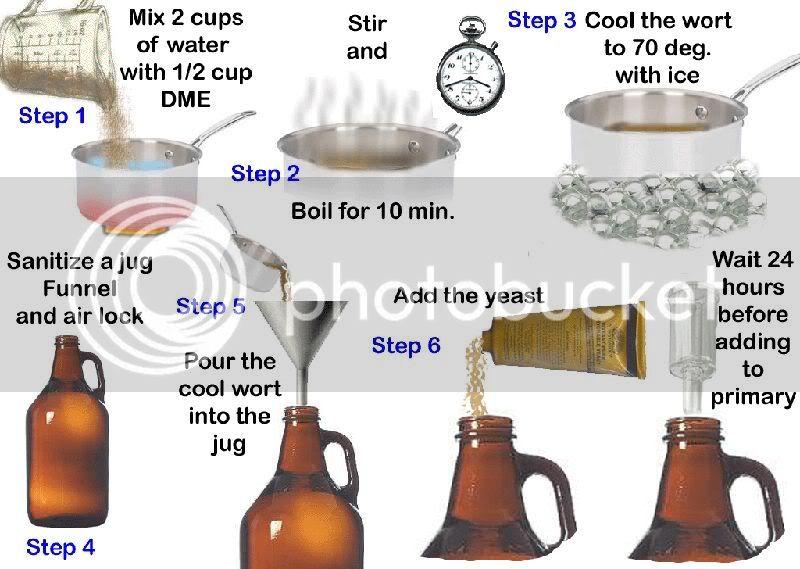RobbyBeer
Well-Known Member
I've heard it is possible to harvest yeast from a bottle of beer. Say I buy a case of this saison brune from my local brewery.. How can harvest the yeast from bottles so I can try my own batch?

RobbyBeer said:I've heard it is possible to harvest yeast from a bottle of beer. Say I buy a case of this saison brune from my local brewery.. How can harvest the yeast from bottles so I can try my own batch?
Assuming you already have all of the equipment to do so, you just prepare a media and use a sample to 'nnoc up a couple petri's....

Depends if they use a separate bottling strain and/or pasteurize or filter their beer.
It surprises me how often I hear this. Many breweries have ONE house yeast.
In order to use a different yeast for bottle conditioning, they would have to keep two yeast strains available, which seems very unlikely to me for many breweries.
Oy vey, talk about overcomplicating a very simple thing. You're right you can do it this way, but who would want to unless you're a lab wonk.
Pablo, if you know how to make a starter, then you can harvest yeast form beer bottles. If you don't know how to make a starter, use this picture as an illustration, but instead of the tube of yeast, drink several beers to about 1-1/2 inches of beer is left behind. Swirl the beer to get the yeast in there. Then sanitize the neck/lip of the bottle. I like to flame it with a lighter or a spirit lamp then spray it with starsan. And pour the beer in.

One thing I have found that helps in successful harvesting, is to use the slurry from multiple bottles of the same beer. I did a really successful Hoegaarden harvest from 12 bottles. What I would do is after pouring the beer into a glass, I would spray the lip of the bottle with starsan and then re-cap with a sanitized cap. Then store in the fridge until I had enough bottles. Then on harvest day I would spray the caps again with starsan, open them, flame the lip of the bottles, and re-spray with sanitizer, then pour the dregs into my starter. I started drinking on Monday, and had enough to make the harvest on Saturday.
I ended up with 2 good sized mason jars with yeast. It's made some really tasty wits since then.
Very few breweries DON'T use the original strain in their bottles, mostly Belgians disguising their strain, and high grav beers that maybe used a champagne strain to aid in carbonation. Most of the time when we see yeast in the bottles, especially microbreweries like Rogue or even Bell's, it IS the strain.
It's not too hard to find out. I usually just google "Harvesting (beer name) yeast" and you can usually find a thread somewhere discussing whether or not it was successful.
This is a pretty good list of beers with harvestable yeasts, though it is waay incomplete and hasn't been updated. It's still a good source. http://www.nada.kth.se/~alun/Beer/Bottle-Yeasts//
But really there's a lot more that the yeast is the same than actually don't....
Very few breweries DON'T use the original strain in their bottles, mostly Belgians disguising their strain, and high grav beers that maybe used a champagne strain to aid in carbonation. Most of the time when we see yeast in the bottles, especially microbreweries like Rogue or even Bell's, it IS the strain.
Most beers have no logical reason to disguise their fermenting strain with another one, so for all intents and purposes you can tend to go with the idea that if it's an american craft beer of moderate gravity that the strain in the bottle IS the fermenting strain.
Not sure why the first part of that post was directed at me. As for the second time you referenced me, I agree that most do. I have posted in many of the harvesting threads recently. Just because most do, doesn't mean that his local brewery does.
Sorry, when I was in create post mode and I scanned up to see what the Original poster's name was, and I thought it was you....
So the starter finally showed signs yesterday nice this Krause formed. I added another quart of 1.040 wort last night and have beer shaking it often. Two questions about this.
Since it took so long to get going should be have any worries about "stress" that the yeast was under?
After I get up two two litters, can I cold crash and decant this yeast to save for a later brew day?
Enter your email address to join: